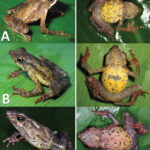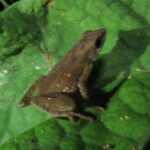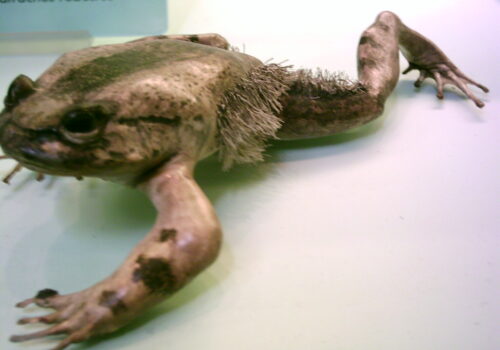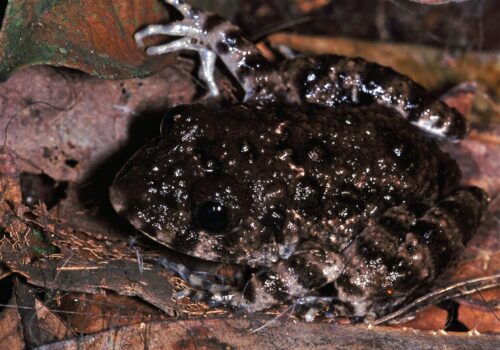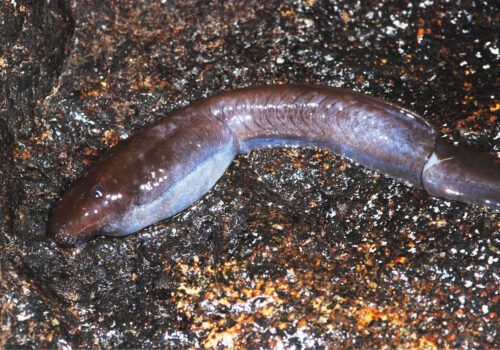- Introduction: A Jewel Amidst the African Foliage
- Taxonomy and Classification: Understanding Its Place in Nature
- Natural Habitat: Life in the Leafy, Moist Realms of the Canopy
- Physical Characteristics: Beauty Designed for Survival
- Behavior and Life Cycle: Nighttime Choruses and Secretive Habits
- Ecological Role: Small Frogs with Big Impact
- Threats and Conservation Status: Vulnerability Amidst Green Havens
- Cultural and Scientific Significance: A Symbol of Forest Stewardship
- Conclusion: Celebrating and Protecting the Enchanting Tree Dwellers
Introduction: A Jewel Amidst the African Foliage#
In the dense, emerald-green canopy of Central Africa’s forests, among twisted vines and lush foliage, exists a creature that few have had the privilege of encountering: the graceful tree frog known as Leptopelis nordequatorialis. Despite its small stature, this amphibian captivates through both its beauty and intriguing behavior. Commonly overshadowed by Africa’s more iconic wildlife, this humble yet riveting species has quietly carved out a niche as an essential component of its ecosystems.
Known scientifically as Leptopelis nordequatorialis, this species, belonging to the family Arthroleptidae, has fascinated herpetologists and conservationists alike since its discovery. Not only does it serve as a vibrant symbol of forest health, but it also exhibits fascinating adaptations to life high within the trees. While its name may be unfamiliar outside scientific circles, the nordequatorialis tree frog embodies the delicate balance of biodiversity that our planet urgently needs.
Taxonomy and Classification: Understanding Its Place in Nature#
The Leptopelis nordequatorialis is firmly nestled within the diverse amphibian family Arthroleptidae, which encompasses various species popularly referred to as screeching frogs or forest tree frogs. Within this richly diverse taxonomic group, the genus Leptopelis stands apart for its arboreal adaptations and melodious mating calls. The genus itself boasts dozens of species spread throughout sub-Saharan Africa, known for their vibrant colors and nocturnal behaviors.
Identified by the renowned herpetologist Jean-Luc Perret in 1966, Leptopelis nordequatorialis closely resembles other Central African members within its genus but is distinguished by specific morphological features and unique vocalizations. Genetic studies affirm its distinctness, forming a small yet vital branch within amphibian biodiversity.
Natural Habitat: Life in the Leafy, Moist Realms of the Canopy#
Geographical Distribution#
This enchanting amphibian primarily inhabits the northern equatorial forest belt of Africa, notably within Cameroon, the Central African Republic, the Republic of Congo, Gabon, and Equatorial Guinea. Favoring regions with dense vegetation and a humid climate, it seeks refuge within mature primary rainforests and always remains associated with pristine conditions, far from disturbance and deforestation. Due to these stringent environmental needs, its presence often signals a habitat in excellent ecological health.
Preferred Habitat Conditions#
Nestled within the cooler layers beneath rainforest canopies, Leptopelis nordequatorialis thrives among epiphytes, mosses, bromeliads, and leafy branches, rarely descending to the forest floor except during breeding. The constant rainfall, high humidity, and lush vegetation create an ideal microclimate for moisture-sensitive amphibians like this beautiful tree frog. Streams and small freshwater sources that meander through the forest floor provide critical breeding grounds, shaping their population distribution significantly. Observing this elusive animal thus offers an immersive experience, taking one’s mind into the mysterious, whispering depths of ancient forests.
Physical Characteristics: Beauty Designed for Survival#
Adorned in hues ranging from vibrant green and lime tones with faint yellowish highlights to rich browns and subtle olive shades, Leptopelis nordequatorialis has evolved to master camouflage in its leafy environment. The coloration varies depending on ambient humidity, temperature, and even emotional states—allowing it unparalleled concealment against predators such as birds, snakes, and small mammals.
Adult frogs typically measure between 40 to 55 millimeters in length, featuring an elegant yet robust physique that supports agile tree-dwelling movements. Large, protruding eyes, positioned strategically on the sides of a tapered head, provide exceptional visual acuity and depth perception essential for their nocturnal lifestyle. Specialized adhesive pads on their limbs and toes grant them impressive climbing abilities, enabling graceful ascents and fearless leaps through forest gaps.
Behavior and Life Cycle: Nighttime Choruses and Secretive Habits#
Feeding and Hunting Strategies#
Emerging from hiding spots at nightfall, these adept predators feast predominantly on a varied diet of insects such as locusts, moths, beetles, and other arthropods. Hunting from favored perches within bushes and low vegetation, they exhibit incredible patience and precision, overcoming prey through ambush tactics. Their quick tongue-and-snatch hunting maneuver leaves observers in awe, demonstrating evolutionary refinement in feeding strategies.
Breeding and Courtship: Serenades in the Rain#
Breeding season marks a dramatic shift in the otherwise subtle behaviors of Leptopelis nordequatorialis. Following heavy rains, their presence becomes particularly noticeable, as males congregate around secluded freshwater pools to entice females with their melodic, bell-like calls. The chorus can sometimes be heard resonating through the night air, creating a natural symphony within the forest.
Following mate selection, females descend briefly from heights rarely traversed to deposit eggs securely hidden within vegetation near still waters. The ensuing tadpoles subsequently drop directly into bodies of water, embarking on aquatic stages lasting several weeks before metamorphosis swiftly guides them back into the arboreal security of canopy life.
Ecological Role: Small Frogs with Big Impact#
Despite their petite size, these tree frogs command a critical influence within rainforest ecosystems. They help regulate insect populations, ensuring balance and indirectly promoting forest health by curbing pest population explosions. Furthermore, their sensitivity to changes in environmental conditions makes them highly effective indicator species; scientists utilize their abundance and behavior patterns to assess ecosystem vitality and health.
In turn, these creatures provide nourishment for higher levels of wildlife—birds, snakes, mammals, and even larger amphibians—completing integral ecological cycles. Understanding their ecological role expands our appreciation of their subtle yet significant presence and sustains our commitment to protecting their habitats.
Threats and Conservation Status: Vulnerability Amidst Green Havens#
Although currently assessed by IUCN as “Least Concern,” recent studies indicate concerns about local population fragmentation, reduction, and declines in abundance across parts of their range. Chief among current threats remains habitat degradation due to logging, commercial agriculture expansion, mining operations, and infrastructure development. Climate change and pollution further amplify these risks, contributing stressors that even robust populations might struggle to withstand.
Thankfully, conservation organizations and herpetological researchers tirelessly advocate for habitat protection measures, sustainable resource management, and thoroughly conducted ecological surveys, seeking to maintain, or even improve, the species’ prospects.
Cultural and Scientific Significance: A Symbol of Forest Stewardship#
Local communities dwelling near these frog populations often imbue them with cultural symbolism, connecting their presence to signals heralding abundant rainfall or positive changes in weather cycles. Their mesmerizing nocturnal calls even inspire local folklore, illustrating a cultural reverence worthy of preservation.
Scientists equally value Leptopelis nordequatorialis for its contribution to biodiversity studies and conservation biology research. Insights gained from observing these amphibians contribute profoundly to ecological understanding—affecting conservation strategies far beyond their canopies.
Conclusion: Celebrating and Protecting the Enchanting Tree Dwellers#
Though modest in stature, the Leptopelis nordequatorialis embodies the delicate interconnectedness inherent to life’s web. Only through informed awareness and conscious conservationism can we hope to maintain thriving habitats like the spectacular Central African rainforest, protecting not merely this species, but countless others sharing its delicate ecosystem balance.
As readers, nature enthusiasts, conservation advocates, and learners, our collective responsibility lies in furthering appreciation, awareness, and action. We urge you to explore further, support local and international conservation efforts, and continue sharing the unique story and delicate beauty of Leptopelis nordequatorialis with the world.


